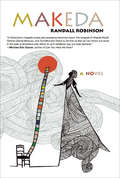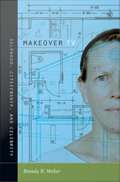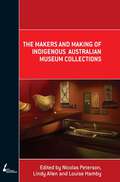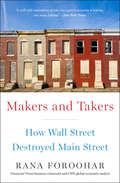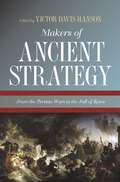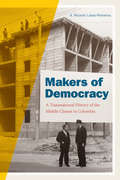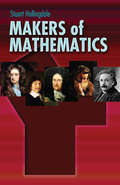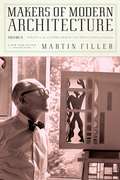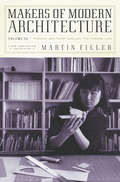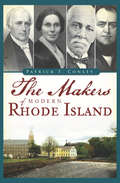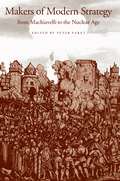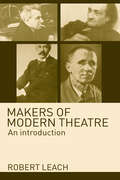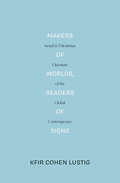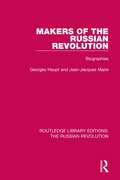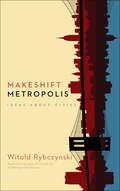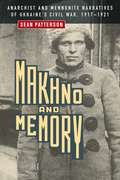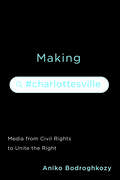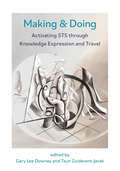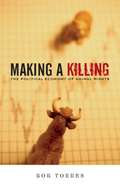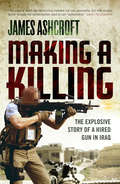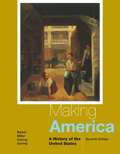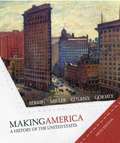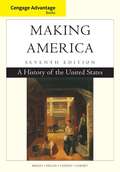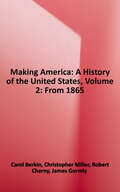- Table View
- List View
Makeda
by Randall RobinsonA &“hypnotic&” novel about the bond between a remarkable African-American matriarch and her grandson in the 1950s South (Essence). Makeda Gee Florida Harris March is a proud matriarch, the anchor and emotional bellwether who holds together a hard-working African American family living in 1950s Richmond, Virginia. Lost in shadow is Makeda&’s grandson Gray, who begins escaping into the magical world of her tiny parlor. Makeda, a woman blind since birth but who has always dreamed in color, begins to confide in Gray the things she &“sees&” and remembers from her dream state, and a story emerges that is layered with historical accuracy beyond the scope of Makeda's limited education. Her connection with Gray will shape his life for years to come. Part coming-of-age story, part spiritual journey, and part love story, Makeda is a universal tale of family, heritage, and the ties that bind. Randall Robinson plumbs the hearts of Makeda and Gray and summons our collective blood memories, taking us on an unforgettable journey of the soul. &“Luminous and magical.&”—Bernice L. McFadden, author of Praise Song for the Butterflies &“Eloquent and erudite, Robinson's oft-times mystical coming-of-age saga teems with rich and evocative historical insights.&”—Booklist &“Robinson is not only exploring what it means to be black. His theme of knowing the past before planning the future applies to all cultures, all people. Pick up this odyssey of family drama, history and love, and be prepared to consider your own beginnings.&”—Shelf Awareness
Makeover TV: Selfhood, Citizenship, and Celebrity
by Brenda R. WeberIn 2004, roughly 25 makeover-themed reality shows aired on U. S. television. By 2009, there were more than 250, from What Not to Wear and The Biggest Loser to Dog Whisperer and Pimp My Ride. In Makeover TV, Brenda R. Weber argues that whether depicting transformations of bodies, trucks, finances, relationships, kids, or homes, makeover shows posit a self achievable only in the transition from the "Before-body"--the overweight figure, the decrepit jalopy, the cluttered home--to the "After-body," one filled with confidence, coded with celebrity, and imbued with a renewed faith in the powers of meritocracy. The rationales and tactics invoked to achieve the After-body vary widely, from the patriotic to the market-based, and from talk therapy to feminist empowerment. The genre is unified by its contradictions: to uncover your "true self," you must be reinvented; to be empowered, you must surrender to experts; to be special, you must look and act like everyone else. Based on her analysis of more than 2,500 hours of makeover TV, Weber argues that the much-desired After-body speaks to and makes legible broader cultural narratives about selfhood, citizenship, celebrity, and Americanness. Although makeovers are directed at both male and female viewers, their gendered logic requires that feminized subjects submit to the controlling expertise wielded by authorities. The genre does not tolerate ambiguity. Conventional (middle-class, white, ethnically anonymous, heterosexual) femininity is the goal of makeovers for women. When subjects are male, makeovers often compensate for perceived challenges to masculine independence by offering men narrative options for resistance or control. Foregoing a binary model of power and subjugation, Weber provides an account of makeover television that is as appreciative as it is critical. She reveals the makeover show as a rich and complicated text that expresses cultural desires and fears through narratives of selfhood.
Makers and Making Of Indigenous Australian Museum Collections
by Nicolas Peterson Lindy Allen Louise HambyThis volume of original essays brings together, for the first time, histories of the making and of the makers of most of the major Indigenous Australian museum collections. These collections are a principal source of information on how Aboriginal people lived in the past. Knowing the context in which any collection was created; the intellectual frameworks within which the collectors were working, their collecting practices, what they failed to collect, and what Aboriginal people withheld; is vital to understanding how any collection relates to the Aboriginal society from which it was derived. Once made, collections have had mixed fates: some have become the jewel of a museum's holdings, while others have been divided and dispersed across the world, or retained but neglected. The essays in this volume raise issues about representation, institutional policies, the periodisation of collecting, intellectual history, material culture studies, Aboriginal culture and the idea of a 'collection'.
Makers and Takers: How Wall Street Destroyed Main Street
by Rana ForooharEight years on from the biggest market meltdown since the Great Depression, the key lessons of the crisis of 2008 still remain unlearned--and our financial system is just as vulnerable as ever. Many of us know that our government failed to fix the banking system after the subprime mortgage crisis. But what few of us realize is how the misguided financial practices and philosophies that nearly toppled the global financial system have come to infiltrate ALL American businesses, putting us on a collision course for another cataclysmic meltdown. Drawing on in-depth reporting and exclusive interviews at the highest rungs of Wall Street and Washington, Time assistant managing editor and economic columnist Rana Foroohar shows how the "financialization of America" - the trend by which finance and its way of thinking have come to reign supreme - is perpetuating Wall Street's reign over Main Street, widening the gap between rich and poor, and threatening the future of the American Dream. Policy makers get caught up in the details of regulating "Too Big To Fail" banks, but the problems in our market system go much broader and deeper than that. Consider that: · Thanks to 40 years of policy changes and bad decisions, only about 15 % of all the money in our market system actually ends up in the real economy - the rest stays within the closed loop of finance itself. · The financial sector takes a quarter of all corporate profits in this country while creating only 4 % of American jobs. · The tax code continues to favor debt over equity, making it easier for companies to hoard cash overseas rather than reinvest it on our shores. · Our biggest and most profitable corporations are investing more money in stock buybacks than in research and innovation. · And, still, the majority of the financial regulations promised after the 2008 meltdown have yet come to pass, thanks to cozy relationship between our lawmakers and the country's wealthiest financiers. Exploring these forces, which have have led American businesses to favor balancing-sheet engineering over the actual kind and the pursuit of short-term corporate profits over job creation, Foroohar shows how financialization has so gravely harmed our society, and why reversing this trend is of grave importance to us all. Through colorful stories of both "Takers" and "Makers," she'll reveal how we change the system for a better and more sustainable shared economic future.From the Hardcover edition.
Makers of Ancient Strategy: From the Persian Wars to the Fall of Rome
by Victor Davis HansonTimeless lessons from the military strategies of the ancient Greeks and RomansIn this prequel to the now-classic Makers of Modern Strategy, Victor Davis Hanson, a leading scholar of ancient military history, gathers prominent thinkers to explore key facets of warfare, strategy, and foreign policy in the Greco-Roman world. From the Persian Wars to the final defense of the Roman Empire, Makers of Ancient Strategy demonstrates that the military thinking and policies of the ancient Greeks and Romans remain surprisingly relevant for understanding conflict in the modern world.The book reveals that much of the organized violence witnessed today—such as counterterrorism, urban fighting, insurgencies, preemptive war, and ethnic cleansing—has ample precedent in the classical era. The book examines the preemption and unilateralism used to instill democracy during Epaminondas's great invasion of the Peloponnesus in 369 BC, as well as the counterinsurgency and terrorism that characterized Rome's battles with insurgents such as Spartacus, Mithridates, and the Cilician pirates. The collection looks at the urban warfare that became increasingly common as more battles were fought within city walls, and follows the careful tactical strategies of statesmen as diverse as Pericles, Demosthenes, Alexander, Pyrrhus, Caesar, and Augustus. Makers of Ancient Strategy shows how Greco-Roman history sheds light on wars of every age. In addition to the editor, the contributors are David L. Berkey, Adrian Goldsworthy, Peter J. Heather, Tom Holland, Donald Kagan, John W. I. Lee, Susan Mattern, Barry Strauss, and Ian Worthington.
Makers of Democracy: A Transnational History of the Middle Classes in Colombia (Radical Perspectives)
by A. Ricardo López-PedrerosIn Makers of Democracy A. Ricardo López-Pedreros traces the ways in which a thriving middle class was understood to be a foundational marker of democracy in Colombia during the second half of the twentieth century. Drawing on a wide array of sources ranging from training manuals and oral histories to school and business archives, López-Pedreros shows how the Colombian middle class created a model of democracy based on free-market ideologies, private property rights, material inequality, and an emphasis on a masculine work culture. This model, which naturalized class and gender hierarchies, provided the groundwork for Colombia's later adoption of neoliberalism and inspired the emergence of alternate models of democracy and social hierarchies in the 1960s and 1970s that helped foment political radicalization. By highlighting the contested relationships between class, gender, economics, and politics, López-Pedreros theorizes democracy as a historically unstable practice that exacerbated multiple forms of domination, thereby prompting a rethinking of the formation of democracies throughout the Americas.
Makers of Mathematics
by Stuart HollingdaleFascinating and highly readable, this book recounts the history of mathematics as revealed in the lives and writings of the most distinguished practitioners of the art: Archimedes, Descartes, Fermat, Pascal, Newton, Leibniz, Euler, Gauss, Hamilton, Einstein, and many more. Author Stuart Hollingdale introduces and explains the roles of these gifted and often colorful figures in the development of mathematics as well as the ways in which their work relates to mathematics as a whole.Although the emphasis in this absorbing survey is primarily biographical, Hollingdale also discusses major historical themes and explains new ideas and techniques. No specialized mathematical knowledge on the part of the reader is assumed. Superbly informative, this volume offers an accessible, interesting guide to one of the pillars of modern science, and to a supremely important aspect of human culture through the ages.
Makers of Modern Architecture, Volume II: From Le Corbusier to Rem Koolhaas
by Martin FillerIn the first volume of Makers of Modern Architecture (2007), Martin Filler examined the emergence of that revolutionary new form of building and explored its aesthetic, social, and spiritual aspirations through illuminating studies of some of its most important practitioners, from Louis Sullivan and Frank Lloyd Wright to, in our own time, Renzo Piano and Santiago Calatrava. Now, in Makers of Modern Architecture, Volume II, Filler continues his investigations into the building art, beginning with the historical eclecticism of McKim, Mead, and White, best remembered today for New York City's demolished Pennsylvania Station. He surveys the seemingly inexhaustible flow of new books about Wright and Le Corbusier, and continues his commentaries on Piano's museum buildings with an essay focused on the new Broad Contemporary Art Museum in Los Angeles. There are less well known subjects here too, from the Frankfurt urban planner Ernst May to Buckminster Fuller, inventor of the geodesic dome. Filler judges Edward Durell Stone--the architect of the U.S. embassy in New Delhi, the Huntington Hartford Museum in New York City, and the Kennedy Center in Washington--to have been "a middling product of his times," however personally interesting he may have been. And he looks back at James Stirling, who in the 1970s and 1980s was "a veritable rock star of the profession," responsible for what Filler considers some of the very few worthwhile postmodernist buildings. The essays collected here are not entirely historical, however. Filler also focuses on some of the most recent projects to have attracted critical and popular attention both in the United States and abroad, including Rem Koolhaas's CCTV building in Beijing and Bernard Tschumi's Acropolis Museum in Athens. He argues that Kazuyo Sejima and Ryue Nishizawa's New Museum in New York City is "one of those rare, clarifying works of architecture that makes most recent buildings of the same sort look suddenly ridiculous." He calls Tod Williams and Billie Tsien's brilliant reimagining of the Barnes Collection in Philadelphia "a latter-day miracle...a virtually unimprovable setting" for its art. He finds Michael Arad's September 11 Memorial at Ground Zero "a sobering, disturbing, heartbreaking, and overwhelming masterpiece." And he argues that Diller Scofidio + Renfro's Institute of Contemporary Art in Boston and their work revitalizing the High Line and Lincoln Center in New York make them today's "shrewdest yet most sympathetic enhancers of the American metropolis." Filler remains, in these nineteen essays, a shrewd observer of the pressures on architects and their projects--money, politics, social expectations, even the weight of their own reputations. But his focus is always on the buildings themselves, on their sincerity and directness, on their form and their function, on their capacity to bring delight to the human landscape.
Makers of Modern Architecture, Volume III: From Antoni Gaudí to Maya Lin
by Martin FillerAn invaluable guide to lives and work of Frank Gehry, Atoni Gaudí, Frank Lloyd Wright, Louis Kahn, Maya Lin, and other important figures of 20th and 21st century architecture.Martin Filler's "contribution to both architecture criticism and general readers' understanding is invaluable," according to Publishers Weekly. This latest installment in his acclaimed Makers of Modern Architecture series again demonstrates his unparalleled skill in explaining the revolutionary changes that have reshaped the built environment over the past century and a half. These studies of more than two dozen master builders--women and men, celebrated and obscure, idealists and opportunists--range from the environmental pioneer Frederick Law Olmsted and the mystical eccentric Antoni Gaudí to the present-day visionaries Frank Gehry and Maya Lin. Filler's broad knowledge embraces everything from the glittering Viennese luxury of Josef Hoffmann to the heavy-duty construction of the New Brutalists, from the low-cost postwar suburbs of the Levitt Brothers to today's super-tall condo towers on Manhattan's Billionaire's Row. Sometimes the interplay of social and political forces leads to dark results, as with Hitler's favorite architect, Albert Speer, and interior designer, Gerdy Troost. More often, though, heroic figures including Frank Lloyd Wright, Louis Kahn, and Lina Bo Bardi offer uplifting inspiration for the future of the one art form we all live with--and in--every day.
Makers of Modern Rhode Island, The (American Heritage Ser.)
by Patrick T. ConleyPicking up where Rhode Island's Founders left off Dr. Patrick T. Conley, Rhode Island's preeminent historian and president of the Rhode Island Heritage Hall of Fame, takes us through the Ocean State's history from 1790 to 1860. Learn how Samuel Slater, the so-called Father of the Factor System, pioneered the making of modern Rhode Island, how Elizabeth Buffum Chace founded the Rhode Island Women's Suffrage Association and what political circumstances led Governor Thomas Wilson Dorr to the Dorr War in 1842. This volume includes colorful biographical sketches of fifty-six influential Rhode Islanders who helped shape the state's urban and industrial development into the modern Rhode Island of today.
Makers of Modern Strategy from Machiavelli to the Nuclear Age: from Machiavelli to the Nuclear Age
by Russell F. WeigleyThe classic reference volume on the theory and practice of warThe essays in this volume analyze war, its strategic characterisitics, and its political and social functions over the past five centuries. The diversity of its themes and the broad perspectives applied to them make the book a work of general history as much as a history of the theory and practice of war from the Renaissance to the present. Makers of Modern Strategy from Machiavelli to the Nuclear Age takes the first part of its title from an earlier collection of essays, published by Princeton University Press in 1943, which became a classic of historical scholarship. Three essays are repinted from the earlier book while four others have been extensively revised. The rest—twenty-two essays—are new.The subjects addressed range from major theorists and political and military leaders to impersonal forces. Machiavelli, Clausewitz, and Marx and Engels are discussed, as are Napoleon, Churchill, and Mao. Other essays trace the interaction of theory and experience over generations—the evolution of American strategy, for instance, or the emergence of revolutionary war in the modern world. Still others analyze the strategy of particular conflicts—the First and Second World Wars—or the relationship between technology, policy, and war in the nuclear age. Whatever its theme, each essay places the specifics of military thought and action in their political, social, and economic environment. Together, the contributors have produced a book that reinterprets and illuminates war, one of the most powerful forces in history and one that cannot be controlled in the future without an understanding of its past.
Makers of Modern Theatre: An Introduction
by Robert LeachWho were the giants of the twentieth-century stage, and exactly how did they influence modern theatre? Robert Leach's Makers of Modern Theatre is the first detailed introduction to the work of the key theatre-makers who shaped the drama of the last century: Konstantin Stanislavsky, Vsevolod Meyerhold, Bertolt Brecht and Antonin Artaud. Leach focuses on the major issues which relate to their dominance of theatre history: *What was significant in their life and times?*What is their main legacy?*What were their dramatic philosophies and practices?*How have their ideas been adapted since their deaths?*What are the current critical perspectives on their work? Never before has so much essential information on the making of twentieth-century theatre been compiled in one brilliantly concise, beautifully illustrated book. This is a genuinely insightful volume by one of the foremost theatre historians of our age.
Makers of Worlds, Readers of Signs: Israeli and Palestinian Literature of the Global Contemporary
by Kfir CohenA sweeping new theory of world literature through a study of Palestinian and Israeli literature from the 1940s to the presentMakers of Worlds, Readers of Signs charts the aesthetic and political formation of neoliberalism and globalization in Israeli and Palestinian literature from the 1940s to the present. By tracking literature’s move from making worlds to reading signs, Cohen Lustig proposes a new way to read theorize our global contemporary. Cohen Lustig argues that the period of Israeli statism and its counterpart of Palestinian statelessness produced works that sought to make and create whole worlds and social time—create the new state of Israel, preserve collective visions of Palestinian statehood.During the period of neoliberalism, the period after 1985 in Israel and the 1993 Oslo Accords in Palestine, literature became about the reading of signs, where politics and history are now rearticulated through the private lives of individual subjects. Here characters do not make social time but live within it and inquire after its missing origin. Cohen Lustig argues for new ways to track the subjectivities and aesthetics produced by larger shifts in production. In so doing, he proposes a new model to understand the historical development of Israeli and Palestinian literature as well as world literature in our contemporary moment. With a preface from Fredric Jameson.
Makers of the Russian Revolution: Biographies (Routledge Library Editions: The Russian Revolution)
by Georges Haupt Jean-Jacques MarieUntil the publication of this book in 1974, the leaders of the October Revolution remained very badly known. This book exhumes the autobiographies written by the men whose actions and ideas have moulded events. Unique as sources of documentation on the Bolsheviks, these autobiographies, encompassing personal and political information up to 1917 add an important historical dimension. They allow the reader to appreciate more accurately the role played by each of the protagonists in preparing and carrying out the Revolution and beyond this they put the Bolsheviks of 1917 in the context of their social milieu and of the circumstances that shaped their minds.
Makeshift Metropolis: Ideas about Cities
by Witold RybczynskiIn this new work, prizewinning author, professor, and Slate architecture critic Witold Rybczynski returns to the territory he knows best: writing about the way people live, just as he did in the acclaimed bestsellers Home and A Clearing in the Distance. In Makeshift Metropolis, Rybczynski has drawn upon a lifetime of observing cities to craft a concise and insightful book that is at once an intellectual history and a masterful critique. Makeshift Metropolis describes how current ideas about urban planning evolved from the movements that defined the twentieth century, such as City Beautiful, the Garden City, and the seminal ideas of Frank Lloyd Wright and Jane Jacobs. If the twentieth century was the age of planning, we now find ourselves in the age of the market, Rybczynski argues, where entrepreneurial developers are shaping the twenty-first-century city with mixed-use developments, downtown living, heterogeneity, density, and liveliness. He introduces readers to projects like Brooklyn Bridge Park, the Yards in Washington, D.C., and, further afield, to the new city of Modi'in, Israel--sites that, in this age of resource scarcity, economic turmoil, and changing human demands, challenge our notion of the city. Erudite and immensely engaging, Makeshift Metropolis is an affirmation of Rybczynski's role as one of our most original thinkers on the way we live today.
Makhno and Memory: Anarchist and Mennonite Narratives of Ukraine's Civil War, 1917–1921
by Sean PattersonNestor Makhno has been called a revolutionary anarchist, a peasant rebel, the Ukrainian Robin Hood, a mass-murderer, a pogromist, and a devil. These epithets had their origins in the Russian Civil War (1917–1921), where the military forces of the peasant-anarchist Nestor Makhno and Mennonite colonists in southern Ukraine came into conflict. In autumn 1919, Makhnovist troops and local peasant sympathizers murdered more than 800 Mennonites in a series of large-scale massacres. The history of that conflict has been fraught with folklore, ideological battles and radically divergent cultural memories, in which fact and fiction often seamlessly blend, conjuring a multitude of Makhnos, each one shouting its message over the other. Drawing on theories of collective memory and narrative analysis, Makhno and Memory brings a vast array of Makhnovist and Mennonite sources into dialogue, including memoirs, histories, diaries, newspapers, and archival material. A diversity of perspectives are brought into relief through the personal reminiscences of Makhno and his anarchist sympathizers alongside Mennonite pacifists and advocates for armed self-defense. Through a meticulous analysis of the Makhnovist-Mennonite conflict and a micro-study of the Eichenfeld massacre of November 1919, Sean Patterson attempts to make sense of the competing cultural memories and presents new ways of thinking about Makhno and his movement. Makhno and Memory offers a convincing reframing of the Mennonite / Makhno relationship that will force a scholarly reassessment of this period.
Making #Charlottesville: Media from Civil Rights to Unite the Right
by Aniko BodroghkozyThe 2017 "Summer of Hate" in Charlottesville became a worldwide media event, putting at center stage the resurgence of emboldened and empowered white supremacy and "alt-right" extremism, as well as the antiracist movement opposing it. Aniko Bodroghkozy’s trenchant study examines this formative moment in recent U.S. history by juxtaposing it against two other epochal moments that put American racism and the struggle against it on worldwide display: the 1963 Birmingham and 1965 Selma campaigns of the civil rights movement. Making #Charlottesville investigates the historical "rhymes" in the mass media’s treatment of these events, separated by half a century, along with the ways that activists on both sides made use of the new media environment of their day to organize and amplify their respective messages. Bodroghkozy teases out the connections, similarities, and resonances among these events—from the ways all three places were consciously chosen as stage sets for media campaigns, to the similarly iconic and heavily circulated images they produced, to the sustained cultural purchase they continue to hold in the United States and around the world.
Making & Doing: Activating STS through Knowledge Expression and Travel
by Gary Lee Downey and Teun Zuiderent-JerakHow ten making & doing projects expand STS scholarship through a focus on knowledge expression and knowledge travel in addition to knowledge production.Making & doing projects expand STS scholarship to include the trajectories of STS knowledge flow beyond the boundaries of the field by actively interweaving knowledge expression and travel with knowledge production. In this edited volume, contributors from around the world present and critically assess ten empirical making & doing projects. They recount how their projects advance STS, and describe how they themselves learn from their interlocutors and the settings in which they do and share their STS work. A coda explains how the infrastructures of STS scholarship are broadening to include practices of making & doing. The contributors examine and reflect upon their dilemmas, frustrations, and failures, especially when these generate new practices that might not have occurred had their work not taken the form of making and doing scholarship. While each project raises a distinct set of scholarly issues, all of the projects include practices that express STS knowledge through &“STS sensibilities&” and attach those sensibilities to practices in empirical fields. The ten projects include one each in Argentina, Taiwan, Canada, and Denmark; two in the US; one in Austria, the UK, and multiple countries in Africa and Asia; one in the US and Latin America; one in the Netherlands and Australia; and one in an international network that includes members from Europe, the Americas, and Australia.
Making A Killing
by Bob TorresSuggest to the average leftist that animals should be part of broader liberation struggles and--once they stop laughing--you'll find yourself casually dismissed. With a focus on labor, property, and the life of commodities, Making a Killing contains key insights into the broad nature of domination, power, and hierarchy. It explores the intersections between human and animal oppressions in relation to the exploitative dynamics of capitalism. Combining nuts-and-bolts Marxist political economy, a pluralistic anarchist critique, as well as a searing assessment of the animal rights movement, Bob Torres challenges conventional anti-capitalist thinking and convincingly advocates for the abolition of animals in industry--and on the dinner plate.Making A Killing is sure to spark wide debate in the animal rights and anarchist movements for years to come.Table Of Contents:I Taking Equality SeriouslyII Chained CommoditiesIII Property, Violence, and the Roots of OppressionIV Animal Rights and WrongsV You Cannot Buy the RevolutionAdvance praise for Making A Killing"Bob Torres' Making a Killing draws a very straight line between capitalism and the oppressive system of animal agribusiness. Drawing from social anarchist theory, Torres provides a convincing argument that in order to fight animal exploitation, we must also fight capitalism and, in doing so, animal rights activists will need to reconsider their methods and redirect their focus. While his critiques of the animal rights movements' large organizations may not earn him friends in high places, such considerations are crucial to keeping the movement on track and for preventing stagnation.Making a Killing is an important work from a new voice in animal advocacy that will surely spark heated discussions amongst activists from all corners of the movement."--Ryan MacMichael, vegblog.org"In Making A Killing: The Political Economy of Animal Rights, Bob Torres takes an important and timely look at the animal rights movement, calling for a synthetic approach to all oppression, human and animal. His analytical framework draws together Marxism, social anarchist theory, and an abolitionist approach to animal rights to provide a timely social analysis that will no doubt have profound effects on the animal rights movement literature."--Gary L. FrancioneDistinguished Professor of Law, Rutgers University"Bob Torres's socioeconomic analysis of nonhuman animal use is a welcome and important addition to the understanding of human-nonhuman relations at the beginning of the 21st century. In particular, Making a Killing, makes vital a contribution to understanding the role of the property status of animals and the continuing strength of various welfarist positions on the ethics--and indeed the economics--of the human utilisation of other animals. Making a Killing will become required reading for social scientists and others interested in modern social movements and the socioeconomic forces that shape their activities and their claims-making."--Dr. Roger Yates, Lecturer in sociology at University College, Dublin, Republic of Ireland"This is the book I've been waiting for. Making A Killing is a rare and powerful example of first-rate scholarship, a searing critique, and lively declaration of the rights of animals and humans. You will walk away from this book with a clear understanding as to why social justice movements for people must take animal rights seriously, and vice versa. Bob Torres has forever deepened my thinking about these relationships."--David Naguib Pellow, vegetarian, animal rights and anti-racist activist, and Professor of Ethnic Studies, University of California, San Diego; and author of Garbage Wars: The Struggle for Environmental Justice in Chicago and Resisting Global Toxics: Transnational Movements for Environmental JusticeBob Torres is assistant professor of sociology at St. Lawrence University, received his PhD from Cornell, and is co-author of Vegan Freak: Being Vegan in a Non-Vegan World. His writings have appeared in Critical Sociology, The Journal of Latinos and Education...
Making A Killing: The Explosive Story of a Hired Gun in Iraq
by James AshcroftIn September 2003, James 'Ash' Ashcroft, a former British Infantry Captain, arrived in Iraq as a 'gun for hire'. It was the beginning of an 18-month journey into blood and chaos.In this action-packed page-turner, Ashcroft reveals the dangers of his adrenalin-fuelled life as a security contractor in Baghdad, where private soldiers outnumber non-US Coalition forces in a war that is slowly being privatised. From blow-by-blow accounts of days under mortar bombardment to revelations about life operating deep within the Iraqi community, Ashcroft shares the real, unsanitised story of the war in Iraq - and its aftermath - direct from the front line.
Making A New Nation: California Vistas 5
by Jana Echevarria James A. Banks Kevin P. Colleary Walter C. Parker Emily M. Schell Stephen F. Cunha James J. Rawis Rosalla SalinasA history book set in accordance with California learning standards.
Making America: A History Of The United States
by Carol Berkin Christopher Miller Robert Cherny James GormlyShaped with a clear political chronology, MAKING AMERICA reflects the variety of individual experiences and cultures that comprise American society. The authors' goal is to spark readers' curiosity and invite them to explore and "do" history rather than simply read about it. The book conveys the surprising twists and turns as well as the individual and collective tales of success and failure that are the real story of the American past. The strongly chronological narrative, together with visuals and an integrated program of learning aids, makes the historical content vivid and comprehensible.
Making America: A History of the United States (5th edition)
by Carol Berkin Christopher L. Miller Robert W. Cherny James L. GormlyThis edition continues to thread the five central themes through the narrative of Making America that professors and students who used earlier editions will recognize. The first of these themes, the political development of the nation, is evident in the text's coverage of the creation and revision of the federal and local governments, the contests waged over domestic and diplomatic policies, the internal and external crises faced by the United States and its political institutions, and the history of political parties and elections. The second theme is the diversity of a national citizenry created by both Native Americans and immigrants. To do justice to this theme, Making America explores not only English and European immigration but immigrant communities from Paleolithic times to the present. The text attends to the tensions and conflicts that arise in a diverse population, but it also examines the shared values and aspirations that define middle-class American lives. Making America's third theme is the significance of regional subcultures and economies. This regional theme is developed for society before European colonization and for the colonial settlements of the seventeenth and eighteenth centuries. It is evident in our attention to the striking social and cultural divergences that existed between the American Southwest and the Atlantic coastal regions and between the antebellum South and North, as well as significant differences in social and economic patterns in the West. A fourth theme is the rise and impact of large social movements, from the Great Awakening in the 1740s to the rise of youth cultures in the post-World War II generations, movements prompted by changing material conditions or by new ideas challenging the status quo. The fifth theme is the relationship of the United States to other nations. In Making America we explore in depth the causes and consequences of this nation's role in world conflict and diplomacy, whether in the era of colonization of the Americas, the eighteenth-century independence movement, the removal of Indian nations from their traditional lands, the impact of the rhetoric of manifest destiny, American policies of isolationism and interventionism, or in the modern role of the United States as a dominant player in world affairs. In this edition, we have continued a sixth theme: American history in a global context. This new focus allows us to set our national development within the broadest context, to point out the parallels and the contrasts between our society and those of other nations. It also allows us to integrate the exciting new scholarship in this emerging field of world or global history.
Making America: A History of the United States (Seventh Edition) (Cengage Advantage Books)
by Carol Berkin Christopher Miller Robert Cherny James GormlyDeveloped to meet the demand for a low-cost, high-quality history book, this economically priced version of MAKING AMERICA, Seventh Edition offers readers the complete narrative while limiting the number of features, photos, and maps. All volumes feature a two-color paperback format that appeals to those seeking a comprehensive, trade-sized history text. Shaped with a clear political chronology, MAKING AMERICA reflects the variety of individual experiences and cultures that comprise American society.
Making America: A History of the United States, 6e, Vol. 2: Since 1865
by Carol Berkin Christopher Miller Robert Cherny James GormlyShaped with a clear political chronology, Making America reflects the variety of individual experiences and cultures that comprise American society. Making America provides a clear, helpful text with a strongly chronological narrative and an integrated program of learning aids that make the historical content vivid and comprehensible to readers at all levels of preparedness.
